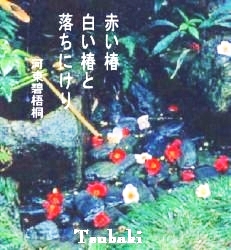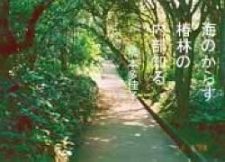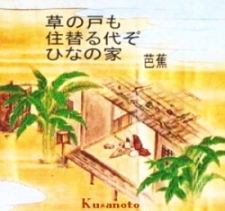|
Akai Tsubaki
Shiroi Tubaki to
ochinikeri
(Kawahigashi Hekigoto)
Red camellia,
and afterwards white camellia
fell down to the ground.
(translated by sigmats)
Umi no Karasu
Tsubaki-bayashi no
Naibu shiru
(Hashimoto Takako)
The sea's crow
knows well the inside
of the camellia grove.
(translated by sigmats)
Takako visited the Ashizuri Peninsula in
Kochi Prefecture in February, 1957. It
was famous for the lighthouse at the
Southern extremity of Shikoku, and
for it camellia. Takako found the inside
of the grove inextricably entangled with
branches like the labyrinth of man's mind,
though beautiful at the distant sight of
crows gently flying towards or away
from it. A few days before her visit, a
young geisha threw herself into the water
from the precipitous cliff, leaving only
her shoes ("geta") with her dancing fan ("mai-ougi").
Takako was much impressed by the tale of the affair.
Jinchouge
aoku kahoreri
susamiyuku
wakaki Inochi no
natsukashiki Yube
(Wakayama Bokusui)
Daphne,
fragrant bluish,
reminding me of an evening in the past,
dear to the blood of my youth,
leaving me desolate bound.
© by Shigeki Matsumura 2004
(translated by sigmats)
Kusa no To mo
sumikawaru Yo zo
Hina no Ie.
(Matsuo Basho)
Time is an eternal traveler.
My bleak house also turned out
to be a new generation's house,
displaying dolls.
(translated by sigmats)
This haiku is placed first in his series, "Oku no
Hosomichi," begun with the famous
sentence, "Tsuhi wa hakutai no kakaku
nisite" (Time is aeternal traveler). Basho
departed the trip for "Oku no Hosomichi"
from Edo on March in 1689. In Japan, we
celebrate the Girls' Festival on March 3.
|













